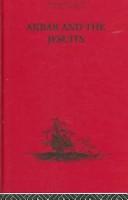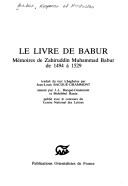| Listing 1 - 10 of 29 | << page >> |
Sort by
|
Book
ISBN: 0195624904 Year: 1989 Publisher: Oxford University Press
Abstract | Keywords | Export | Availability | Bookmark
 Loading...
Loading...Choose an application
- Reference Manager
- EndNote
- RefWorks (Direct export to RefWorks)

ISBN: 8175364440 1134285086 1280241101 9786610241101 0203307526 9780203307526 9780415344814 0415344816 0415344816 9781134285082 9781280241109 6610241104 Year: 2005 Publisher: London : RoutledgeCurzon,
Abstract | Keywords | Export | Availability | Bookmark
 Loading...
Loading...Choose an application
- Reference Manager
- EndNote
- RefWorks (Direct export to RefWorks)
First published in 1926.'These documents are full of intimate interest' Times Literary Supplement'A serious and intensely interesting piece of work' The GuardianThe Jesuit missionaries were some of the earliest Europeans to find their way into the Mogul empire in the sixteenth century. Spending more years at Akbar's court than others did months, and traversing his dominions from Lahore to Kabul, and from Kashmir to the Deccan, they undoubtedly sowed the seeds of British influence in the East.Reproducing, or summarizing the most valuable of the missionaries' l
Missions --- Akbar, --- Jesuits --- Mogul Empire --- Mughal Empire

ISBN: 2716901465 9782716901468 Year: 1980 Publisher: Paris: Publications orientalistes de France,
Abstract | Keywords | Export | Availability | Bookmark
 Loading...
Loading...Choose an application
- Reference Manager
- EndNote
- RefWorks (Direct export to RefWorks)
Book
ISBN: 1350987573 1838608966 1838608974 9781838608965 9781786734358 1786734354 9781786724359 1786724359 9781838608972 9781780767246 1780767242 Year: 2019 Publisher: London : Bloomsbury Publishing,
Abstract | Keywords | Export | Availability | Bookmark
 Loading...
Loading...Choose an application
- Reference Manager
- EndNote
- RefWorks (Direct export to RefWorks)
"One of the most remarkable artistic achievements of the Mughal Empire was the emergence in the early seventeenth century of portraits of identifiable individuals, unprecedented in both South Asia and the Islamic world. Appearing at a time of increasing contact between Europe and Asia, portraits from the reigns of the great Mughal emperor-patrons Akbar, Jahangir and Shah Jahan are among the best-known paintings produced in South Asia. In the following centuries portraiture became more widespread in the visual culture of South Asia, especially in the rich and varied traditions of painting, but also in sculpture and later prints and photography. This collection seeks to understand the intended purpose of a range of portrait traditions in South Asia and how their style, setting and representation may have advanced a range of aesthetic, social and political functions. The chapters range across a wide historical period, exploring ideals of portraiture in Sanskrit and Persian literature, the emergence and political symbolism of Mughal portraiture, through to the paintings of the Rajput courts, sculpture in Tamil temples and the transformation of portraiture in colonial north India and post-independence Pakistan. This specially commissioned collection of studies from a strong list of established scholars and rising stars makes a significant contribution to South Asian history, art and visual culture."--Bloomsbury Publishing.
Islamic art --- Painting, Mogul Empire --- History. --- Influence. --- Painting, Mughal Empire
Book
ISBN: 9781009253673 1009253670 1009253697 9781009253703 9781009253666 1009253719 1009253700 9781009253710 9781009253697 Year: 2024 Publisher: Cambridge : Cambridge University Press,
Abstract | Keywords | Export | Availability | Bookmark
 Loading...
Loading...Choose an application
- Reference Manager
- EndNote
- RefWorks (Direct export to RefWorks)
Rishad Choudhury presents a new history of imperial connections across the Indian Ocean from 1739 to 1857, a period that witnessed the decline and collapse of Mughal rule and the consolidation of British colonialism in South Asia. In this highly original and comprehensive study, he reveals how the hajj pilgrimage significantly transformed Muslim political culture and colonial attitudes towards it, creating new ideas of religion and rule. Examining links between the Indian Subcontinent and the Ottoman Middle East through multilingual sources - from first-hand accounts to administrative archives of hajj - Choudhury uncovers a striking array of pilgrims who leveraged their experiences and exchanges abroad to address the decline and decentralization of an Islamic old regime at home. Hajjis crucially mediated the birth of modern Muslim political traditions around South Asia. Hajj across Empires argues they did so by channeling inter-imperial crosscurrents to successive surges of imperial revolution and regional regime change.
Muslim pilgrims and pilgrimages --- History. --- Mogul Empire --- Civilization --- Mughal Empire
Book
ISBN: 1283169347 9786613169341 1409416070 9781409416074 9781283169349 661316934X 9781409413684 1409413683 Year: 2010 Publisher: Farnham, Surrey Burlington, VT [London] Ashgate Hakluyt Society
Abstract | Keywords | Export | Availability | Bookmark
 Loading...
Loading...Choose an application
- Reference Manager
- EndNote
- RefWorks (Direct export to RefWorks)
Diplomats --- Voyages and travels --- Roe, Thomas, --- East India Company. --- India --- Mogul Empire. --- History --- Mughal Empire.
Book
ISBN: 131702673X 1317026748 1315556472 1283015412 9786613015419 1409416224 9781409416227 1409413837 9781409413837 9781409413837 9781317026747 9781315556475 9781283015417 6613015415 Year: 2010 Publisher: Farnham, Surrey Ashgate
Abstract | Keywords | Export | Availability | Bookmark
 Loading...
Loading...Choose an application
- Reference Manager
- EndNote
- RefWorks (Direct export to RefWorks)
Voyages and travels. --- East India Company. --- East Indies. --- Mogul Empire. --- Mughal Empire.
Book
ISBN: 0231547846 9780231547840 9780231174367 9780231174374 Year: 2019 Publisher: New York, NY : Columbia University Press,
Abstract | Keywords | Export | Availability | Bookmark
 Loading...
Loading...Choose an application
- Reference Manager
- EndNote
- RefWorks (Direct export to RefWorks)
In the early modern world, the Safavid, Ottoman, and Mughal empires sprawled across a vast swath of the earth, stretching from the Himalayas to the Indian Ocean to the Mediterranean Sea. The diverse and overlapping literate communities that flourished in these three empires left a lasting legacy on the political, religious, and cultural landscape of the Near East and India. This volume is a comprehensive sourcebook of newly translated texts that shed light on the intertwined histories and cultures of these communities, presenting a wide range of source material spanning literature, philosophy, religion, politics, mysticism, and visual art in thematically organized chapters. Scholarly essays by leading researchers provide historical context for closer analyses of a lesser-known era and a framework for further research and debate. The volume aims to provide a new model for the study and teaching of the region's early modern history that stands in contrast to the prevailing trend of examining this interconnected past in isolation.
Iran --- Turkey --- Mogul Empire --- History --- History. --- Civilization. --- Civilization --- Mughal Empire --- Sources.
Book
ISBN: 1283015285 9786613015280 1409416089 9781409416081 9781409413691 1409413691 9781283015288 6613015288 Year: 2010 Volume: 2nd ser., no. 2 Publisher: Farnham, Surrey : Ashgate,
Abstract | Keywords | Export | Availability | Bookmark
 Loading...
Loading...Choose an application
- Reference Manager
- EndNote
- RefWorks (Direct export to RefWorks)
Voyages and travels. --- East India Company. --- India. --- Mogul Empire. --- Mughal Empire.
Book
ISBN: 9004352848 9789004352841 9789004340473 9004340475 Year: 2018 Publisher: Leiden, The Netherlands ; Boston, [Massachusetts] : Brill,
Abstract | Keywords | Export | Availability | Bookmark
 Loading...
Loading...Choose an application
- Reference Manager
- EndNote
- RefWorks (Direct export to RefWorks)
Affect, Emotion and Subjectivity in Early Modern Muslim Empires presents new approaches to Ottoman Safavid and Mughal art and culture. Taking artistic agency as a starting point, the authors consider the rise in status of architects, the self-fashioning of artists, the development of public spaces, as well as new literary genres that focus on the individual subject and his or her place in the world. They consider the issue of affect as performative and responsive to certain emotions and actions, thus allowing insights into the motivations behind the making and, in some cases, the destruction of works of art. The interconnected histories of Iran,Turkey and India thus highlight the urban and intellectual changes that defined the early modern period. Contributors are: Sussan Babaie, Chanchal Dadlani, Jamal Elias, Emine Fetvaci, Christiane Gruber, Sylvia Hougteling, Kishwar Rizvi, Sunil Sharma, and Marianna Shreve Simpson.
Emotions in art. --- Art, Ottoman. --- Art, Mogul Empire. --- Art, Safavid. --- Architecture, Mogul Empire. --- Art, Moghul Empire --- Art, Mogul --- Art, Mughal Empire --- Art, Mughul Empire --- Moghul Empire art --- Mogul Empire art --- Mughal Empire art --- Mughul Empire art --- Ottoman art --- Safavid art --- Architecture, Indo-Muslim --- Architecture, Moghul Empire --- Architecture, Mogul --- Architecture, Mughal Empire --- Architecture, Mughul Empire --- Indo-Muslim architecture --- Moghul Empire architecture --- Mogul Empire architecture --- Mughal Empire architecture --- Mughul Empire architecture --- Turkey --- India --- Iran --- Civilization --- Civilization. --- Art, Mughal Empire. --- Architecture, Mughal Empire.
| Listing 1 - 10 of 29 | << page >> |
Sort by
|

 Search
Search Feedback
Feedback About UniCat
About UniCat  Help
Help News
News